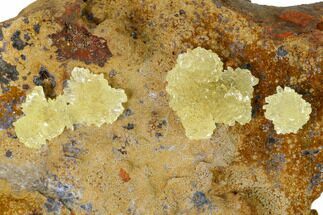This Specimen has been sold.
3.1" Gemmy Austinite Crystals on Matrix - Ojuela Mine, Mexico
This is a beautiful specimen of gemmy, yellow-green austinite crystals on a limonite matrix, collected from the Ojuela Mine in Durango, Mexico. The entire specimen measures 3.1" wide.
Austinite is a member of the adelite-descloizite group and has the chemical formula CaZn(AsO4)(OH). It forms in oxidized arsenic-rich metal deposits and is often associated with adamite, limonite, talmessite, and quartz. It often exhibits a greenish coloration, though it has also been known to occur as yellow, brown, white and yellow-white aggregations. Austinite has been collected from the United States, Mexico, Australia, Bolivia, Namibia and several other locations.
Austinite was named after Austin Flint Rodgers, an American mineralogist at Stanford University.
Austinite was named after Austin Flint Rodgers, an American mineralogist at Stanford University.
About The Ojuela Mine
Ojuela is not one mine but a complex of multiple mines in the same general area, located just northwest of Mapimi, Mexico. It was established in 1598 after the discovery of an old abandoned silver and gold mine. As mineral production increased and the mineral potential was confirmed, the town (Ojuela settlement) adjacent to the mine, along with the city of Mapimi, began to grow as well. The mining settlement was such a success that it contained a post office, warehouses, stores, saloons, a church, and housing for the miners. Once minerals were collected, they were processed in Mapimi, which also played a role in the rapid development of the city. Around the start of the 20th century, most of the mineral deposits were exhausted, resulting in the abandonment of the mines and settlement.
The mine is well known by mineral collectors for its aresenate minerals and a variety of other mineral species: approximately 117 have been identified from the area. Some of the most popular minerals include adamite, austinite, hemimorphite, scorodite, platternite, aurichalcite, rosasite, calcite, wulfenite, mimetite, iridescent goethite, and fluorite.
Ojuela is not one mine but a complex of multiple mines in the same general area, located just northwest of Mapimi, Mexico. It was established in 1598 after the discovery of an old abandoned silver and gold mine. As mineral production increased and the mineral potential was confirmed, the town (Ojuela settlement) adjacent to the mine, along with the city of Mapimi, began to grow as well. The mining settlement was such a success that it contained a post office, warehouses, stores, saloons, a church, and housing for the miners. Once minerals were collected, they were processed in Mapimi, which also played a role in the rapid development of the city. Around the start of the 20th century, most of the mineral deposits were exhausted, resulting in the abandonment of the mines and settlement.
The mine is well known by mineral collectors for its aresenate minerals and a variety of other mineral species: approximately 117 have been identified from the area. Some of the most popular minerals include adamite, austinite, hemimorphite, scorodite, platternite, aurichalcite, rosasite, calcite, wulfenite, mimetite, iridescent goethite, and fluorite.
SPECIES
Austinite
LOCATION
Ojuela Mine, Mapimi, Durango, Mexico
SIZE
Entire specimen 3.1 x 2.1"
CATEGORY
ITEM
#219841
 Reviews
Reviews













